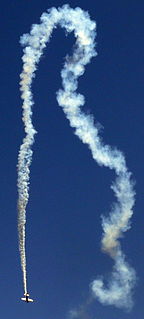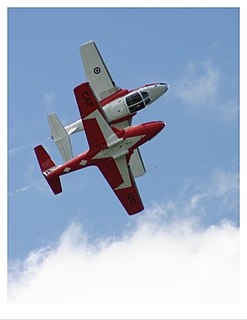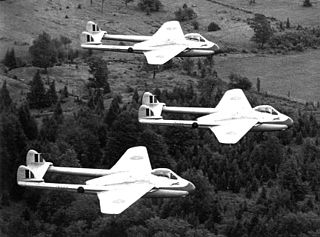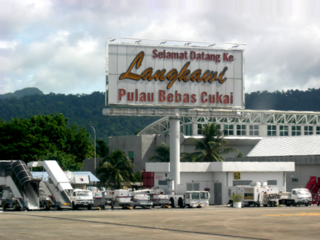
Aerobatics is the practice of flying maneuvers involving aircraft attitudes that are not used in normal flight. Aerobatics are performed in airplanes and gliders for training, recreation, entertainment, and sport. Additionally, some helicopters, such as the MBB Bo 105, are capable of limited aerobatic maneuvers. An example of a fully aerobatic helicopter, capable of performing loops and rolls, is the Westland Lynx.

The Canadair CT-114 Tutor was the Royal Canadian Air Force (RCAF), and later Canadian Forces, standard jet trainer, between the early 1960s and 2000. Designed and built by Canadair, it was ordered in September 1961.

Surya Kiran is an aerobatics demonstration team of the Indian Air Force. The Surya Kiran Aerobatic Team (SKAT) was formed in 1996 and are a part of the 52nd Squadron of the IAF. The team has since performed numerous demonstrations usually with nine aircraft. The squadron was composed of the HAL HJT-16 Kiran Mk.2 military trainer aircraft till 2011 and were based at the Bidar Air Force Station in Karnataka. The team was suspended in February 2011 and was re-established with Hawk Mk-132 aircraft in 2017.

The Royal International Air Tattoo (RIAT) is the world's largest military air show, held annually over the third weekend in July, usually at RAF Fairford in Gloucestershire, England in support of The Royal Air Force Charitable Trust. The show typically attracts a total of 150,000 to 160,000 spectators over the weekend.

The Extra Flugzeugbau EA300 is a two-seat aerobatic monoplane capable of Unlimited category competition. It was designed in 1987 by Walter Extra, a German aerobatic pilot, and built by Extra Flugzeugbau.

The Royal Malaysian Navy (RMN) is the naval arm of the Malaysian Armed Forces.

The Blue Devils or the 410 (F) Squadron Aerobatic Team was a Royal Canadian Air Force (RCAF) aerobatic team that flew the de Havilland Vampire jet aircraft from 1949 to 1951. The unit was the RCAF's first postwar aerobatic team, and belonged to the RCAF's first operational jet fighter squadron, No. 410 Squadron.

The Turkish Stars are the aerobatic demonstration team of the Turkish Air Force and the national aerobatics team of Turkey.

The August 1st or Ba Yi Aerobatics Team is the aerobatic demonstration team of the People's Liberation Army Air Force. It is named after the date of the founding of the PLA, and is a part of the PLAAF Beijing Military Region. The unit was founded in 1962 and has over the years performed more than 500 times for delegations from 166 countries and regions. Its first show abroad happened in August 2013 during the Russian airshow MAKS.
Langkawi International Maritime and Aerospace Exhibition (LIMA) is a maritime and aerospace exhibition that takes place once every two years in Langkawi, Malaysia. The last event took place in 2019.

Langkawi International Airport, is an airport in Padang Matsirat, Langkawi, Kedah, Malaysia.

RMAF Butterworth is an Air Force Station of the Royal Malaysian Air Force (RMAF) situated 4.5 nautical miles from Butterworth in Penang, Malaysia. It is also currently home to the Headquarters Integrated Area Defence System (HQIADS), part of the Five Power Defence Arrangements for Malaysia and Singapore, which is commanded by an Australian Air Vice Marshal.

The Sukhoi Su-30MKM is a supermaneuverable fighter of the Royal Malaysian Air Force. It is a variant of the Su-30 series fighters, with many significant improvements over the original Su-30MK export version. The Su-30MKM was developed by the Sukhoi Design Bureau and is based on the Su-30MKI of the Indian Air Force. Both aircraft have common airframe, thrust vectoring engines and digital fly-by-wire system, However the MKM version differs from the MKI mainly in the composition of the onboard avionics. It can carry up to 8,000 kg/ 17,650 lb of weapons and payloads over 700 nmi unrefueled combat radius.

The Royal Moroccan Air Force, RMAF, is the air force branch of the Moroccan Armed Forces.
Malaysia's armed forces, which encompasses three major branches, originate from the formation of local military forces in the first half of the 20th century, during British colonial rule of Malaya and Singapore prior to Malaya's independence in 1957. The branches have undergone several restructuring, but fundamentally includes the army, navy and air force.

The Pasukan Khas TUDM – it is better known as PASKAU – is an elite special force within the Royal Malaysian Air Force. Its main function is to carry out high-value targets protection, ground forward air controller, combat search and rescue and rescuing downed aircrews assignments. PASKAU also tasked as a principal anti-hijack response to civil and military aircraft. All PASKAU members are airborne and commando-trained and can be deployed behind enemy lines via air, sea and land, to assist in target designation for Malaysian Armed Forces and RMAF offensive missions. The PASKAU Headquarters is known as RMAF Regiment.

The Jupiter Aerobatic Team is the current Indonesian Air Force aerobatic display team flying with six KT-1B Wongbee aircraft painted in red and white. The team is drawn from the Skadik 102, Adisucipto International Airport, Yogyakarta. The Jupiter team aircraft are equipped with white smoke generators. The pilots of the "Jupiter Aerobatic Team (JAT)" are all instructors. The team is named "JUPITER" after the call-sign of Indonesian Air Force instructors.
The equipment of the Royal Malaysian Air Force can be subdivided into: aircraft, ammunition, weapons, satellites, and ground vehicles.
















